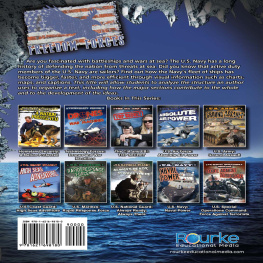1996 by The Kent State University Press,
Kent, Ohio 44242
ALL RIGHTS RESERVED
Library of Congress Catalog Card Number 96-12755
ISBN 0873385500
Manufactured in the United States of America
05 04 03 02 01 00 99 98 97 96 5 4 3 2 1
Library of Congress Cataloging-in-Publication Data
Slagle, Jay, 1946
Ironclad captain : Seth Ledyard Phelps and the U. S. Navy, 18411864 / Jay Slagle ; with a foreword by Edwin C. Bearss.
p. cm.
Includes bibliographical references and index.
ISBN 0-87338-550-0 (cloth : alk. paper)
1. Phelps, Seth Ledyard, d. 1885. 2. Ship captainsUnited StatesBiography. 3. United States. NavyBiography. 4. United StatesHistoryCivil War, 18611865Naval operations. 5. Mexican War, 18461848Naval operations, American. I. Title.
E467.1.P56S58 1996
973.7'5dc20 96-12755
British Library Cataloging-in-Publication data are available.
A LIFELONG ROMANCE with the Civil Warits personalities and the rank and file, its heroism, tragedy, and pathosbegan in the bitter winter of 193536, when I was twelve. I lived with my parents on a cattle ranch at Sarpy, Montana, forty miles from town and three miles from the nearest neighbors. My father, a World War I marine, was a history buff, and on winter evenings he read to my brother and me. Among the books he chose, most of which focused on his war and the Marine Corps, was John W. Thomasons J. E. B. Stuart. I was hooked.
Until I attended graduate school at Indiana University in 195355, my readingsand beginning in April 1949, when I acquired a car, my visits to battlefieldscentered on the war in the East and the titanic struggle between the Armies of the Potomac and Northern Virginia. At Indiana University, I broadened my horizons to include the Western armies and their leaders; the title of my masters thesis is Patrick R. Cleburne: Stonewall Jackson of the West.
Not until September 1955, when I joined the National Park Service and was stationed at Vicksburg National Military Park, did I begin to delve into what was happening afloat, particularly on the Mississippi and other great rivers of Americas heartland. This was necessary if I were to understand and interpret to park visitors the fourteen months of campaigns that led to the surrender of Vicksburg and Port Hudson, permitting President Abraham Lincoln to announce, The Father of Waters again goes unvexed to the Sea.
During my first months at Vicksburg, I became familiar with volumes 1827 of Official Records of the Union and Confederate Navies in the War of the Rebellion, which addressed the activities of the West Gulf Blockading Squadron and naval forces on western waters. I read Alfred Thayer Mahans The Gulf and Inland Waters; H. Allen Gosnells Guns on the Western Waters: The Story of the River Gunboats in the Civil War; Richard S. Wests Mr. Lincolns Navy; Loyall Farraguts Life and Letters of Admiral Farragut: First Admiral of the U.S. Navy; and David Dixon Porters Incidents and Anecdotes of the Civil War and The Naval History of the Civil War.
These books, along with articles in Battles and Leaders of the Civil War focusing on the river war, fired my enthusiasm. I came to understand and appreciate the significance of the partnership between the Union Army and Uncle Sams webfeet that gave birth to many of the principles of amphibious warfare honed by the United States and Japan in World War II, and that spelled disaster for the Confederacy on the western rivers and the North and South Carolina sounds. Denied this partnership, armies led by Maj. Gen. Ulysses S. Grant, John Pope, and Nathaniel P. Banksparticularly Grantsconfronted by vast distances and mud roads, would, as they thrust deep into the Souths heartland, have suffered fates similar to those of Charles XII in Russia in 17089, Napoleon Bonaparte in the same country in 1812, and, in our time, Adolf Hitlers Wehrmacht in the Soviet Union in the late autumn of 1941 and the winter of 194142.
My interest in the riverine war was heightened in the late summer of 1956, when the possibility of locating the hulk of the Eads City Series ironclad Cairo, sunk by an infernal machine in the Yazoo River, was discussed with a friend, Warren E. Grabou, a geologist and Civil War buff. Joined by Max Donald Jacks, a riverman, in November we pinpointed and identified the ironclad. Cairo, after much hard work and heartache, was salvaged and is now a popular attraction at Vicksburg National Military Park.
What does the foregoing have to do with Lt. Comdr. Seth Ledyard Phelps? So long as my research centered on the 1863 Vicksburg campaign, Phelps was not a major player. But this focus changed in October 1958. With the National Park Service making plans to enhance its interpretive exhibits and programs to meet challenges stimulated by increased visits during the Civil War centennial years, I became research historian for the Southeast Region. My duty station was Vicksburg, but I served the research needs of most of the Civil War parks.
My first projects took me to Stones River and Fort Donelson National Military Parks. At the latter my initial project aimed at supporting restoration of the lower water battery and was titled Gunboat Operations at Forts Henry and Donelson. It was then that I came to know and appreciate Seth Phelps. One of the first naval officers ordered to the Midwest, he pioneered in building from scratch the mighty Mississippi Squadron that, beginning at Fort Henry in February 1862, teamed with the army to strangle Confederate hopes and dreams on the western waters. As captain of Conestoga, he popped up everywhere during these early months of the war. Prowling the lower reaches of the Cumberland and Tennessee rivers, he showed the flag, encouraging pro-Union Kentuckians and overawing secessionists. He was an active participant in the Fort Henry drama. He next led the dash up the Tennessee River by the three timber-clads as far as Muscle Shoals, dismaying Confederates and capturing or destroying all steamboats on the river below Chattanooga.
A tangible result of broadening my horizons was publication in historical journals in the early 1960s of monographs titled The Fall of Fort Henry (West Tennessee Historical Society Publications, 1963); A Federal Raid Up the Tennessee River (Alabama Review, 1964); and The Union Raid Down the Mississippi and Up the Yazoo, August 1427, 1862 (Military Affairs, 1962). In 1963, the Vicksburg Centennial Commission published Rebel Victory at Vicksburg, the story of the unsuccessful efforts by the Union Navy to capture the Confederate Gibraltar in the late spring and summer of 1862. Phelps commanded the two raiding flotillas, and had an important role at Fort Henry and at Vicksburg in July 1862; but never, until I had the pleasure of reading his personal correspondence as presented by Jay Slagle, did I know the man or appreciate his significance to the outfitting and early success of the squadron, and the interpersonal relationships that add flesh and substance to the matter-of-fact tone in much of the official correspondence and entries in the ships logs.












